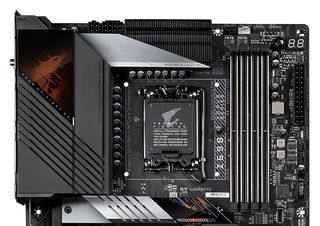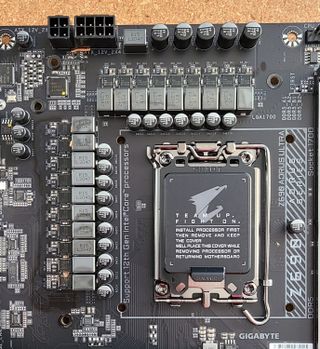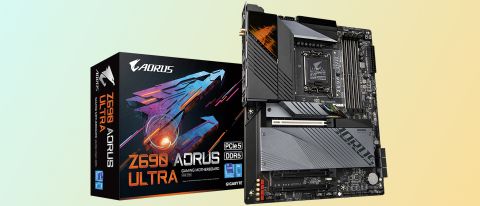Tom's Hardware Verdict
The Gigabyte Z690 Aorus Ultra is a solid Alder Lake option or $350. You get four M.2 sockets, 2.5 GbE and integrated Wi-Fi 6, overbuilt VRMs, and an updated appearance. It compares well to similarly priced Z690 options.
Pros
- +
+ Overbuilt 105A power delivery
- +
+ 12 total rear USB ports
- +
+ Four M.2 sockets
Cons
- -
Looks may not be for everyone
- -
No PCIe 5.0 M.2 socket
Why you can trust Tom's Hardware
Gigabyte’s Z690 Aorus Ultra looks quite impressive on paper–or whatever your preferred specs-reading device is these days. With its more palatable $349.99 price, it comes with four M.2 sockets (none PCIe 5.0 though), 105A SPS MOSFETs, the latest audio codec, USB 3.2 Gen 2x2 (20 Gbps) Type-C ports, and of course support for the Alder Lake processors.
Compared to the previous-gen Z590 version, Gigabyte went with a more contrasting grey on the VRM and M.2 heatsinks. There’s less surface area on the heatsinks/shrouds on the bottom half of the board, so more of the motherboard and its PCB gets exposed, which is an interesting design choice. The company also improved the power delivery by adding more phases and better MOSFETs to help support this generation’s power-hungry processors. In all, this model is still more iterative than a complete overhaul, but an improvement nonetheless. The only thing that really stands out is the secondary M.2 and chipset heatsink, which are effectively a giant grey rectangle against the black board.
As far as performance goes, the Z690 Aorus Ultra did well in all the gaming tests and posted above-average results in most of the tests. But it was slower in the Procyon benchmark and average in our real-world and other benchmarks. In short, if you’re not paying very close attention, you likely wouldn’t notice a difference between this and most other Z690motherboards, as the performance difference isn’t significant in most tests.
Does the Gigabyte Z690 Aorus Ultra deserve a spot on our best motherboards list? It does deliver a pleasing amount of features for the price. Do its overbuilt VRMs, copious amount of USB ports, or anything else set it apart? We’ll delve into all that and more to determine if this board is a worthwhile purchase among the similarly priced competition. But before we start, here’s a complete list of the Gigabyte Z690 Aorus Ultra specifications from the company’s website.
Specifications - Gigabyte Z690 Aorus Ultra
| Socket | LGA1700 |
| Chipset | Z690 |
| Form Factor | ATX |
| Voltage Regulator | 18 Phase (16+2, 105A MOSFETs for Vcore) |
| Video Ports | (1) DisplayPort (v1.4) |
| USB Ports | (1) USB 3.2 Gen 2x2 Type-C port (20 Gbps) |
| Row 6 - Cell 0 | (4) USB 3.2 Gen 2 Type-C port (10 Gbps) |
| Row 7 - Cell 0 | (4) USB 3.2 Gen 1 (5 Gbps) |
| Row 8 - Cell 0 | (4) USB 2.0 (480 Mbps) |
| Network Jacks | (1) 2.5 GbE |
| Audio Jacks | (2) Analog + SPDIF |
| Legacy Ports/Jacks | ✗ |
| PCIe x16 | (1) v. 5.0 (x16) |
| Row 13 - Cell 0 | (2) v. 3.0 (x4) |
| PCIe x8 | ✗ |
| PCIe x4 | ✗ |
| PCIe x1 | ✗ |
| CrossFire/SLI | AMD Quad-GPU CrossFire and 2-Way Crossfire |
| DIMM slots | (4) DDR4 6200+(OC), 128GB Capacity |
| M.2 slots | (1) PCIe 4.0 x4 (64 Gbps) / PCIe (up to 110mm) |
| Row 20 - Cell 0 | (2) PCIe 4.0 x4 (64 Gbps) / PCIe (up to 110mm) |
| Row 21 - Cell 0 | (1) PCIe 4.0 x4 (64 Gbps) / PCIe + SATA (up to 110mm) |
| U.2 Ports | ✗ |
| SATA Ports | (6) SATA3 6 Gbps (Supports RAID 0/1/5/10) |
| USB Headers | (1) USB v3.2 Gen 2x2, Type-C (20 Gbps) |
| Row 25 - Cell 0 | (1) USB v3.2 Gen 1 (5 Gbps) |
| Row 26 - Cell 0 | (2) USB v2.0 (480 Mbps) |
| Fan/Pump Headers | (8) 4-Pin (CPU, Water cooling CPU, System, System/Pump fans) |
| RGB Headers | (2) aRGB Gen2 (3-pin) |
| Row 29 - Cell 0 | (2) RGB (4-pin) |
| Diagnostics Panel | 2-character debug LED, Q-LED |
| Internal Button/Switch | Reset and Q-Flash buttons |
| SATA Controllers | ✗ |
| Ethernet Controller(s) | Intel I225-V (2.5 Gbps) |
| Wi-Fi / Bluetooth | Intel AX200 Wi-Fi 6 (2x2 ax, MU-MIMO, 2.4/5/6 GHz, 160 MHz, BT 5.2) |
| USB Controllers | Realtek RTS5411 (2) |
| HD Audio Codec | Realtek ALC4080 |
| DDL/DTS | ✗ / Y, DTS Ultra |
| Warranty | 3 Years |
The Aorus Ultra includes the basics in its accessory stack, housed below the motherboard. You get SATA cables, a Wi-Fi antenna, etc. Below is a list of everything included with this board.
- (6) SATA 6Gb/s cables
- Wi-Fi antenna
- (4) M.2 screw sets
- Microphone
- User Manual / Guide
- Aorus badge
- G-connector
- (2) Temperature probes
- RGB extension cable



Taking a closer look at the board, we first noticed the oversized finned heatsinks for the VRM, the large M.2 heatsink for the top socket, and the large grey heatsink for the remainder of the M.2 sockets. The design is simple, though the large grey heatsink on the bottom sticks out, adding a stark contrast. This look will likely be polarizing, as some like the contrasts and others like a more consistent color scheme. Personally, I like the appearance and it should fit well into most build themes.
On the RGB front, if you’re looking for a light show from the board, you’ll have to look elsewhere. The only included RGB element is the Aorus Eagle above the rear IO. Outside of that, you’ll need to use the board’s integrated RGB headers to add your own. Onboard lighting and any lights connected via the headers are controlled by the Gigabyte RGB Fusion application.

Starting with the top half of the board, we run into the VRM heatsinks that use Gigabyte’s Fins-Array II design for increased surface and better cooling. An 8mm heatpipe connects the two heatsinks to share the load between them. The Aorus Ultra uses high-conductivity thermal pads for efficient heat transfer. Just above the CPU socket are two EPS connectors, a required 8-pin and optional 4-pin.
To the right of the LGA 1700 socket, we spy four DRAM slots reinforced with Gigabyte’s Ultra Durable SMD Memory armor. While reinforced DRAM slots aren’t necessary from a weight and shearing standpoint, the EMI mitigation can help with stability, especially when you’re trying to push the highest possible overclocks. The Aorus ultra supports 128GB of DDR5 with speeds listed up to DDR5 6200. Your mileage will always vary in trying to reach these speeds as you need the right kit and a solid memory controller on the processor to do so.
We run into the first two (of eight total) 4-pin fan headers above the DRAM slots, CPU_FAN and CPU_OPT. All fan headers output up to 2A/24W. The power is enough to support most pumps and piggyback a couple of fans on the same header. Be sure to check the requirements for the attached parts, as you do not want to overload these headers. Next to the fan headers are the RGB headers. Here we have a 3-pin ARGB and 4-pin RGB. We’ll run into the other headers on the bottom edge of the board.
Moving down the right edge, we run into the Power button, the 2-character debug LED, 24-pin ATX to power the board, and two more 4-pin fan headers. For USB headers, there’s a 15-pin front panel USB 3.2 Gen 1 (5 Gbps) header and a USB 3.2 Gen 2x2 Type-C header as well.
Last but not least is the 4-LED debug. The four LEDs labeled CPU, Boot, VGA, and DRAM, light up through the POST process. If something fails, the LED for the problematic component remains lit, letting you know at a high level where the problem is. This coupled with the two-character debug above should give you an accurate idea of what the problem may be.

For the VRMs, Gigabyte implemented a 19-phase setup, with 16 phases dedicated to Vcore. Power is sent from the EPS connector(s) onto a 20-channel Renesas RAA229131 PWM controller and onto the 16 105A Renesas RAA2210540 SPS MOSFETs. The 1,680 Amps is one of the higher values on Z690 and arguably the best at its price point. The Aorus Ultra can easily handle our Intel i9-12900K processor at stock and while overclocked using ambient cooling methods. This board’s VRMs won’t be the limiting factor if you're into sub-ambient cooling for sport.

Shifting our attention to the bottom half of the board, we’re greeted by more shrouds and heatsinks covering most of the board. On the left side, we find the Realtek ALC4080 flagship audio codec under a plastic shroud. Dotted around the audio chip are a few Chemicon brand audio caps and four WIMA audio caps in red. While the Aorus Ultra doesn’t include a DAC like its big brother (Aorus Master), the audio solution is good enough for most users.
There are four M.2 sockets and three full-length PCIe slots in the middle of the board. Starting with the PCIe slots, the top slot (white) is reinforced and runs at up to PCIe 5.0 x16, sourcing lanes directly from the CPU. The bottom two slots are fed from the chipset and run up to PCIe 3.0 x4 speeds. This configuration supports AMD Quad-GPU CrossFire and 2-WAY AMD CrossFire technologies.
Located between and around the PCIe slots are the four M.2 sockets. The top socket sports an oversized heatsink to help keep the PCIe 4.0 x4 drive (up to 110mm) running cool under load. The second and third sockets, M2P_SB and M2Q_SB, also support PCIe 4.0 x4 modules up to 110mm. The difference between these and the top socket is that the former get their bandwidth from the chipset while the top socket is connected through the CPU. Finally, the bottom socket, M2C_SB, supports PCIe x4 and SATA-based modules up to 110mm.
Continuing right, across the chipset and onto the right edge, we run into six-pin and four-pin Thunderbolt headers. Just below those are the six SATA ports. SATA ports 2/3 share lanes with the M2C_SB, so if a device uses that socket, those SATA ports get disabled. You can run four M.2-based storage modules and four SATA-based devices at the same time, which should be enough for most users.
Finally, across the bottom edge of the board, we find a slew of headers ranging from USB to RGB and even some sensors in between. Here’s a complete list ordered from left to right:
- Front panel audio
- 3-pin ARGB header
- 4-pin RGB header
- Noise sensor
- TPM header
- (2) USB 2.0 headers
- Q-Flash button
- (4) System fan headers
- Temperature sensor header
- Clear CMOS jumper
- Front panel header
- Reset button

Swinging back to the rear IO area, we’ve got a pre-installed IO plate that matches the Aorus Ultra’s theme. It has a black background with white writing, so the port information is easy to read. There are 13 total USB ports around the back: one USB 3.2 Type-C port (20 Gbps), four USB 3.2 Gen 2 (10 Gbps) ports, four USB 3.2 Gen 1 (5 Gbps) ports, and finally, four USB 2.0 (480 Mbps) ports. The 12 USB Type-A ports are plenty for most users. If you plan to use the integrated video on some of the Alder Lake processors, there’s a DisplayPort (v1.4) connector. Missing from the Ultra (but found on the higher-end Master) are the Clear CMOS buttons to flash the BIOS and reset it – you’ll have to use the button on the board. The audio stack consists of two analog plugs and a SPDIF port. Last but not least are connections for the Wi-Fi 6 antenna and the Intel 2.5 GbE port.
MORE: Best Motherboards
MORE: How To Choose A Motherboard
MORE: All Motherboard Content

Joe Shields is a Freelance writer for Tom’s Hardware US. He reviews motherboards.
